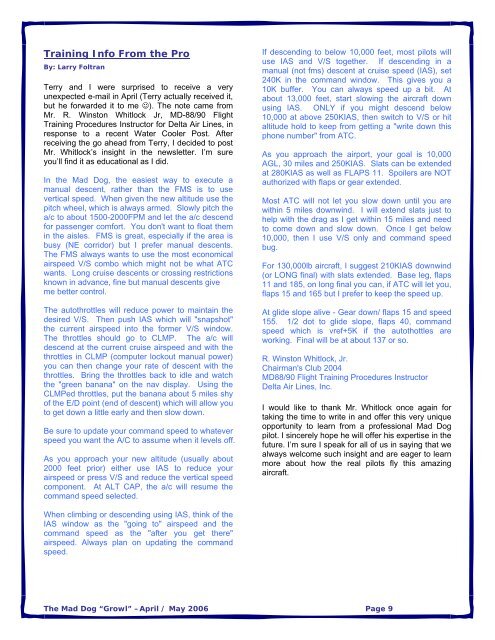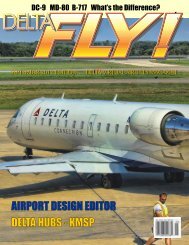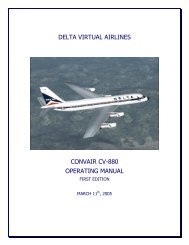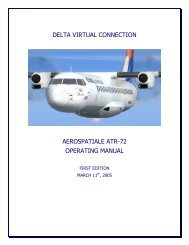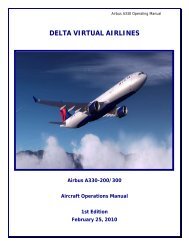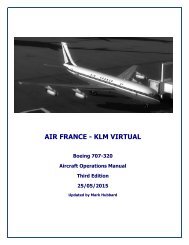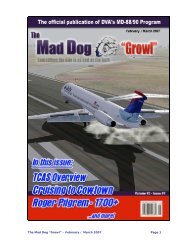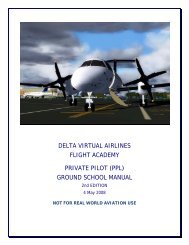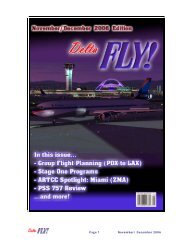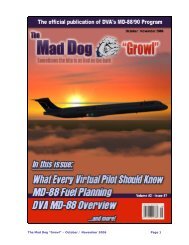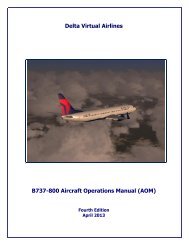The Mad Dog âGrowlâ âApril / May 2006 Page 1 - Delta Virtual Airlines
The Mad Dog âGrowlâ âApril / May 2006 Page 1 - Delta Virtual Airlines
The Mad Dog âGrowlâ âApril / May 2006 Page 1 - Delta Virtual Airlines
Create successful ePaper yourself
Turn your PDF publications into a flip-book with our unique Google optimized e-Paper software.
Training Info From the Pro<br />
By: Larry Foltran<br />
Terry and I were surprised to receive a very<br />
unexpected e-mail in April (Terry actually received it,<br />
but he forwarded it to me ☺). <strong>The</strong> note came from<br />
Mr. R. Winston Whitlock Jr, MD-88/90 Flight<br />
Training Procedures Instructor for <strong>Delta</strong> Air Lines, in<br />
response to a recent Water Cooler Post. After<br />
receiving the go ahead from Terry, I decided to post<br />
Mr. Whitlock’s insight in the newsletter. I’m sure<br />
you’ll find it as educational as I did.<br />
In the <strong>Mad</strong> <strong>Dog</strong>, the easiest way to execute a<br />
manual descent, rather than the FMS is to use<br />
vertical speed. When given the new altitude use the<br />
pitch wheel, which is always armed. Slowly pitch the<br />
a/c to about 1500-2000FPM and let the a/c descend<br />
for passenger comfort. You don't want to float them<br />
in the aisles. FMS is great, especially if the area is<br />
busy (NE corridor) but I prefer manual descents.<br />
<strong>The</strong> FMS always wants to use the most economical<br />
airspeed V/S combo which might not be what ATC<br />
wants. Long cruise descents or crossing restrictions<br />
known in advance, fine but manual descents give<br />
me better control.<br />
<strong>The</strong> autothrottles will reduce power to maintain the<br />
desired V/S. <strong>The</strong>n push IAS which will "snapshot"<br />
the current airspeed into the former V/S window.<br />
<strong>The</strong> throttles should go to CLMP. <strong>The</strong> a/c will<br />
descend at the current cruise airspeed and with the<br />
throttles in CLMP (computer lockout manual power)<br />
you can then change your rate of descent with the<br />
throttles. Bring the throttles back to idle and watch<br />
the "green banana" on the nav display. Using the<br />
CLMPed throttles, put the banana about 5 miles shy<br />
of the E/D point (end of descent) which will allow you<br />
to get down a little early and then slow down.<br />
Be sure to update your command speed to whatever<br />
speed you want the A/C to assume when it levels off.<br />
As you approach your new altitude (usually about<br />
2000 feet prior) either use IAS to reduce your<br />
airspeed or press V/S and reduce the vertical speed<br />
component. At ALT CAP, the a/c will resume the<br />
command speed selected.<br />
If descending to below 10,000 feet, most pilots will<br />
use IAS and V/S together. If descending in a<br />
manual (not fms) descent at cruise speed (IAS), set<br />
240K in the command window. This gives you a<br />
10K buffer. You can always speed up a bit. At<br />
about 13,000 feet, start slowing the aircraft down<br />
using IAS. ONLY if you might descend below<br />
10,000 at above 250KIAS, then switch to V/S or hit<br />
altitude hold to keep from getting a "write down this<br />
phone number" from ATC.<br />
As you approach the airport, your goal is 10,000<br />
AGL, 30 miles and 250KIAS. Slats can be extended<br />
at 280KIAS as well as FLAPS 11. Spoilers are NOT<br />
authorized with flaps or gear extended.<br />
Most ATC will not let you slow down until you are<br />
within 5 miles downwind. I will extend slats just to<br />
help with the drag as I get within 15 miles and need<br />
to come down and slow down. Once I get below<br />
10,000, then I use V/S only and command speed<br />
bug.<br />
For 130,000lb aircraft, I suggest 210KIAS downwind<br />
(or LONG final) with slats extended. Base leg, flaps<br />
11 and 185, on long final you can, if ATC will let you,<br />
flaps 15 and 165 but I prefer to keep the speed up.<br />
At glide slope alive - Gear down/ flaps 15 and speed<br />
155. 1/2 dot to glide slope, flaps 40, command<br />
speed which is vref+5K if the autothottles are<br />
working. Final will be at about 137 or so.<br />
R. Winston Whitlock, Jr.<br />
Chairman's Club 2004<br />
MD88/90 Flight Training Procedures Instructor<br />
<strong>Delta</strong> Air Lines, Inc.<br />
I would like to thank Mr. Whitlock once again for<br />
taking the time to write in and offer this very unique<br />
opportunity to learn from a professional <strong>Mad</strong> <strong>Dog</strong><br />
pilot. I sincerely hope he will offer his expertise in the<br />
future. I’m sure I speak for all of us in saying that we<br />
always welcome such insight and are eager to learn<br />
more about how the real pilots fly this amazing<br />
aircraft.<br />
When climbing or descending using IAS, think of the<br />
IAS window as the "going to" airspeed and the<br />
command speed as the "after you get there"<br />
airspeed. Always plan on updating the command<br />
speed.<br />
<strong>The</strong> <strong>Mad</strong> <strong>Dog</strong> “Growl” –April / <strong>May</strong> <strong>2006</strong> <strong>Page</strong> 9


